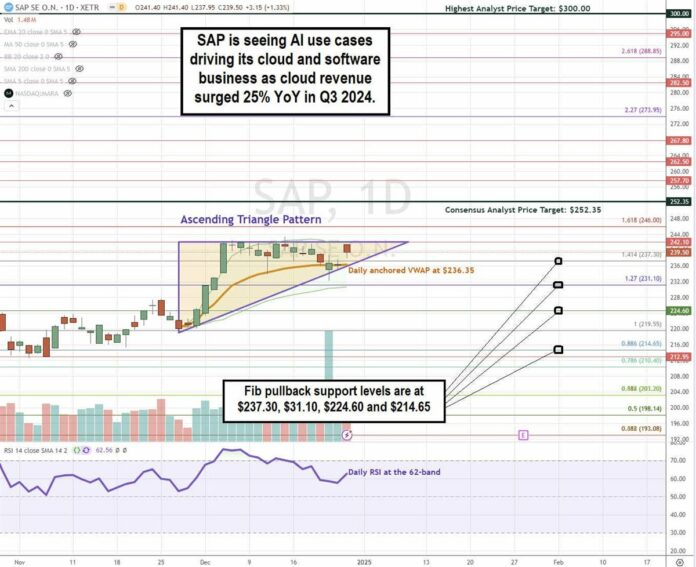SAP SE Surges with AI Boost; Analysts Eye Upward Movement
Global enterprise software leader SAP SE (NYSE: SAP) is nearing record highs, driven by momentum from artificial intelligence (AI). The acronym SAP stands for Systems, Applications, and Products in Data Processing, emphasizing its role in delivering cloud-based business software through its flagship enterprise resource planning (ERP) product.
This comprehensive software package integrates various business solutions—from accounting and human capital management (HCM) to customer relationship management (CRM), project management, and procurement—into one platform. By integrating AI and machine learning features, SAP tailors its software to reflect the unique requirements of different industries.
Significant Growth: AI Deal Involvement Surged in Q3
The positive impact of AI was apparent in SAP’s third-quarter 2024 results, which showcased a 6% year-over-year growth in adjusted earnings per share to $1.33, exceeding analysts’ expectations by 2 cents. Revenue also rose 9.4% year-over-year to $9.17 billion, surpassing the consensus estimate of $9.15 billion. Additionally, the company saw its cloud backlog increase by 25% year-over-year, reaching $15.38 billion. In this context, Cloud ERP Suite revenue grew 34% year-over-year to $3.67 billion, while total cloud revenue rose 25% year-over-year, amounting to $4.35 billion.
For the past four years, SAP has been engaged in a continual transformation to the cloud, and this transition has gained momentum due to AI. Approximately 30% of its cloud order entries in the quarter incorporated AI use cases. Furthermore, SAP accomplished its goal of developing 100 AI applications across its suite. Notably, AI usage among SAP customers increased more than fourfold during this period. The company also finalized its $1.5 billion acquisition of the digital adoption platform WalkMe.
Steady Growth Expected in the Future
Looking ahead, SAP anticipates that this upward momentum will persist. They have increased their cloud and software revenue forecast by $433 million to a range between $31.93 billion and $32.24 billion. They expect cloud revenue to fall between $18.41 billion and $18.73 billion, keeping their initial estimates intact.
Although SAP does not foresee margin challenges in 2025, the potential impacts of AI on gross margins in subsequent years remain uncertain. Nevertheless, the company believes AI will positively influence margins. The strong AI trend in 2024 suggests confidence in a robust Q4 for the company.
Stock Movement: SAP Forms an Ascending Triangle
In technical analysis, an ascending triangle pattern consists of a flat-top upper trendline that resists breakout while aligning with an ascending lower trendline that supports price increases. A breakout occurs when the stock price surpasses the upper trendline. Conversely, if the stock price falls below the lower trendline, the pattern is considered a breakdown.

SAP’s upper trendline resistance stands at $242.10, converging with a lower ascending trendline initiated around a swing low of $219.55. The stock has tested the upper resistance nearly eight times without a successful breakout, while the ascending trendline has been tested twice. The daily anchored volume-weighted average price (VWAP) support is at $236.35, with the daily Relative Strength Index (RSI) rising to the 62-band. Key Fibonacci pullback support levels include $237.30, $231.10, $224.60, and $214.65.
Analysts have an average consensus price target of $252.35 for SAP, indicating a potential upside of 0.96%, with the highest price target reaching $300.00. The stock currently holds eight Buy ratings and one Hold rating, while short interest is minimal at 0.11%.
Potential Investment Strategies: Investors feeling optimistic may explore cash-secured puts at Fibonacci pullback support levels to capture the dip. Should they acquire shares, writing covered calls at upward Fibonacci levels can provide additional income, complementing SAP’s 0.69% dividend yield.
The views and opinions expressed herein are the views and opinions of the author and do not necessarily reflect those of Nasdaq, Inc.

